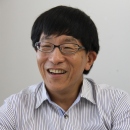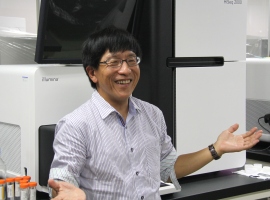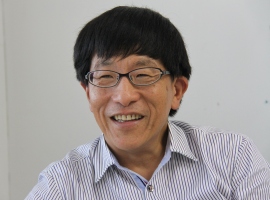INOUE, Ituro M. D., Professor

Medicine becoming the scientific discipline owing to Genomic approach
- Using Next-Generation Sequencer to identify genes responsible for orphan diseases
- Next-Generation Sequencer is a recently developed device that is able to determine massive scale of DNA sequences. Throughput capacity of the most updated devise is 600G base pairs in a single session.
 Prof. Inoue says, “Next-Generation Sequencer completes whole genome sequencing of individual in 10 days what the Human Genome Project required 15 years to find out. It’s a totally different world of affairs, a paradigm shift. We have seven Next-Generation Sequencers at the NIG.” He uses the Next-Generation Sequencers to analyze the genes of patients of extremely rare diseases to identify culprit genes. There are about 7,000 genetic orphan diseases, most of whose causes are unknown. “Now that we have the Next-Generation Sequencers, this is what I must do. I’m convinced that the mysteries of most orphan diseases will be clarified all at once.” Dr. Inoue is in contact with hospitals, which inform him of the families of orphan disease patients. He analyses the genes of the family members in the hope for identifying the genes that cause the diseases. He does not limit the scope of his research to specific diseases but extend any diseases that sequencing technology has a merit to uncover.
Prof. Inoue says, “Next-Generation Sequencer completes whole genome sequencing of individual in 10 days what the Human Genome Project required 15 years to find out. It’s a totally different world of affairs, a paradigm shift. We have seven Next-Generation Sequencers at the NIG.” He uses the Next-Generation Sequencers to analyze the genes of patients of extremely rare diseases to identify culprit genes. There are about 7,000 genetic orphan diseases, most of whose causes are unknown. “Now that we have the Next-Generation Sequencers, this is what I must do. I’m convinced that the mysteries of most orphan diseases will be clarified all at once.” Dr. Inoue is in contact with hospitals, which inform him of the families of orphan disease patients. He analyses the genes of the family members in the hope for identifying the genes that cause the diseases. He does not limit the scope of his research to specific diseases but extend any diseases that sequencing technology has a merit to uncover.- Ideal: competition-free research scientist
- Dr. Inoue has been conducting his research on the principle of avoiding competition as much as possible. He explains his approach: “Competition occurs in a popular area where many players with similar ideas congregate. If one works with one’s own unique idea, no competition should occur. My ideal research scientist does not engage in competition. Competing with other researchers is most boring because your question is likely to be answered in a year or so even if you do nothing. Instead, it is desirable to be a pioneer of a new field and many researchers will follow your research after the success. This is something important to keep in mind.” He advises future research scientists as follows: “Research scientists basically do what they like, but the result is mostly a series of failures. Even so, you enjoy your research, and keep working on it. Some speak about the ‘joy of discovery,’ that is the motivation of research, but that rarely happens to you (laughter). We’re not particularly well paid, and it’s hard to find employment. Even that situation, if you still enjoy research, then you have a talent to be a researcher.” What do researchers do when they run into a major obstacle? “There’re two possibilities. One is quitting. The other is persevering. Either way, you better to stop once, in order to continue. Then one day, while reading somebody else’s paper or else, you come up with a brilliant idea and solve your problem.”
- Medicine as a scientific discipline in its own right
 Dr. Inoue obtained his degrees in Medicine. As an undergraduate student, he was shocked by what one of his professors mentioned about scientific part of medicine, “Medicine cannot be a scientific discipline”. “What this professor meant by is that no immutable system represents Medicine because it serves its purpose when patients are cured, with older treatment methods constantly being replaced by newer ones.” However, at the University of Utah in the United States, Dr. Inoue encountered Human Genetics and knew that it is the scientific discipline for him to pursue. “I then made up my mind to thoroughly study Genetics because this discipline can lead us to determining the causes of diseases, clarifying their mechanisms, and hence developing treatment methods, which give disciplines or principles to medicine.”
Dr. Inoue obtained his degrees in Medicine. As an undergraduate student, he was shocked by what one of his professors mentioned about scientific part of medicine, “Medicine cannot be a scientific discipline”. “What this professor meant by is that no immutable system represents Medicine because it serves its purpose when patients are cured, with older treatment methods constantly being replaced by newer ones.” However, at the University of Utah in the United States, Dr. Inoue encountered Human Genetics and knew that it is the scientific discipline for him to pursue. “I then made up my mind to thoroughly study Genetics because this discipline can lead us to determining the causes of diseases, clarifying their mechanisms, and hence developing treatment methods, which give disciplines or principles to medicine.”- Age of research into humans
- “At present, human beings provide the most genomic information among all the livings. This is the first time in life science that humans become a major subject of studies. With advances in DNA sequencing technologies, we’re now entering the age of research into humans. The times are indeed changing.”
- (Interviewed by Yoshiko Tamura 2011)
Back

 Prof. Inoue says, “Next-Generation Sequencer completes whole genome sequencing of individual in 10 days what the Human Genome Project required 15 years to find out. It’s a totally different world of affairs, a paradigm shift. We have seven Next-Generation Sequencers at the NIG.” He uses the Next-Generation Sequencers to analyze the genes of patients of extremely rare diseases to identify culprit genes. There are about 7,000 genetic orphan diseases, most of whose causes are unknown. “Now that we have the Next-Generation Sequencers, this is what I must do. I’m convinced that the mysteries of most orphan diseases will be clarified all at once.” Dr. Inoue is in contact with hospitals, which inform him of the families of orphan disease patients. He analyses the genes of the family members in the hope for identifying the genes that cause the diseases. He does not limit the scope of his research to specific diseases but extend any diseases that sequencing technology has a merit to uncover.
Prof. Inoue says, “Next-Generation Sequencer completes whole genome sequencing of individual in 10 days what the Human Genome Project required 15 years to find out. It’s a totally different world of affairs, a paradigm shift. We have seven Next-Generation Sequencers at the NIG.” He uses the Next-Generation Sequencers to analyze the genes of patients of extremely rare diseases to identify culprit genes. There are about 7,000 genetic orphan diseases, most of whose causes are unknown. “Now that we have the Next-Generation Sequencers, this is what I must do. I’m convinced that the mysteries of most orphan diseases will be clarified all at once.” Dr. Inoue is in contact with hospitals, which inform him of the families of orphan disease patients. He analyses the genes of the family members in the hope for identifying the genes that cause the diseases. He does not limit the scope of his research to specific diseases but extend any diseases that sequencing technology has a merit to uncover. Dr. Inoue obtained his degrees in Medicine. As an undergraduate student, he was shocked by what one of his professors mentioned about scientific part of medicine, “Medicine cannot be a scientific discipline”. “What this professor meant by is that no immutable system represents Medicine because it serves its purpose when patients are cured, with older treatment methods constantly being replaced by newer ones.” However, at the University of Utah in the United States, Dr. Inoue encountered Human Genetics and knew that it is the scientific discipline for him to pursue. “I then made up my mind to thoroughly study Genetics because this discipline can lead us to determining the causes of diseases, clarifying their mechanisms, and hence developing treatment methods, which give disciplines or principles to medicine.”
Dr. Inoue obtained his degrees in Medicine. As an undergraduate student, he was shocked by what one of his professors mentioned about scientific part of medicine, “Medicine cannot be a scientific discipline”. “What this professor meant by is that no immutable system represents Medicine because it serves its purpose when patients are cured, with older treatment methods constantly being replaced by newer ones.” However, at the University of Utah in the United States, Dr. Inoue encountered Human Genetics and knew that it is the scientific discipline for him to pursue. “I then made up my mind to thoroughly study Genetics because this discipline can lead us to determining the causes of diseases, clarifying their mechanisms, and hence developing treatment methods, which give disciplines or principles to medicine.”














